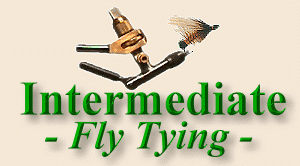You're not in the wrong place. This series crossed the line from
'beginning' to 'intermediate' a while back. By naming it more correctly I
hope more tiers will jump in and join us.
Something old, something new. That's what this week offers. For the
old, it's deer hair heads and palmer wrapped hackle. For the new it's a
slightly different wing and body. Dave's hopper doesn't offer any real
exciting new challenges, nor is it so easy to tie that it should be
bypassed.
What it offers the fisherman is a hopper pattern that's caught more
trout than any other hopper pattern I know of with the possible exception
of Joe's hopper. Hmmm, so many hoppers, so many first names. I wonder
if that's some sort of tradition or something?
Dave's hopper is a tradition to many western flyfishers. It's the first
hopper pattern I had consistent success with. Once you master spinning
deer hair, it will be one of the easiest hopper patterns you tie. I
suppose that's reason enough to learn how to tie it.
Fly fishermen (and women) owe a debt of gratitude to Dave Whitlock. Not
only did he design Dave's Hopper, he designed a lot of other flies we
fish with as well. If you've seen the Matuka, the Mouse Rat or any of
several dozen bass and saltwater patterns (Redhead flies for instance),
you've looked at some of his contributions to the fly fishing world. His
nymph and streamer patterns are standards at most fly shops. In fact,
his contributions to fly fishing in terms of patterns, are broader and
more numerous than the contributions of Lee Wulff.
One interesting note, Dave's hopper can be tied with all-black materials
to create a cricket, or stonefly colors to imitate any of the stoneflies
that inhabit our mountain streams. The possible variations of this one
fly are endless, and even though I've studied several dozen variations,
I'm sure I've just scratched the surface of the pile. Do you have
cicadas where you live? If so, a variation of this pattern will work to
imitate them as well.
The original Dave's Hopper was tied with trimmed hackle legs that were
knotted and bent to shape. Later variations of this pattern used knotted
pheasant tail fibers, rubber hackle and hair for legs. Unless I'm tying
this pattern for sale, I don't add legs. After years of fishing legged
and leg-less versions of this pattern, I found that the only thing it
catches better with legs is fishermen. They're a nice touch, and if you
wish to add them you can, but I haven't shown them here. For now, just
concentrate on creating a nice looking body and head.
The version of Dave's Hopper you are about to see is my own, and has
several changes from the original. In fact, if you pick up several dozen
pattern books, you'll likely see a dozen variations of this pattern.
I'll try to point out the differences as we go along, but please don't
get the idea that I'm the authoritative expert who must be followed on
this or any other pattern. I expect that in time, you too will have
variations of many original patterns you learn to tie, even patterns of
my design. Hey, that's what this tying thing is all about.
Artistic expression is one of the main draws to fly tying. It certainly
isn't saving or making money. I'll bet you've figured that one out by
now. But if you can express yourself through personalizing your
patterns, you will gain a whole new enjoyment of this sport and the art
of fly tying.
|










